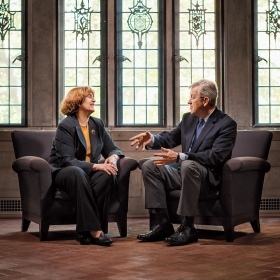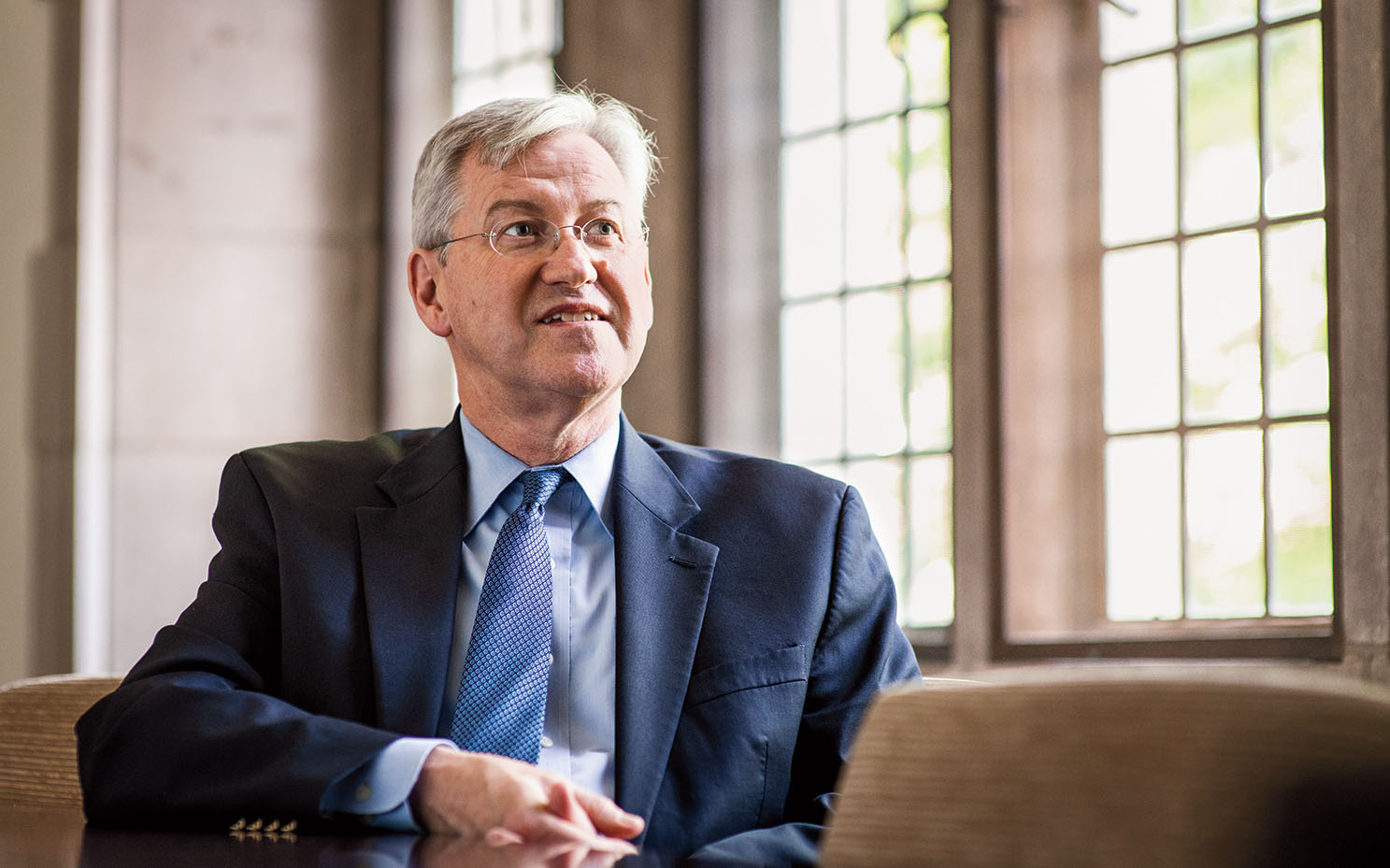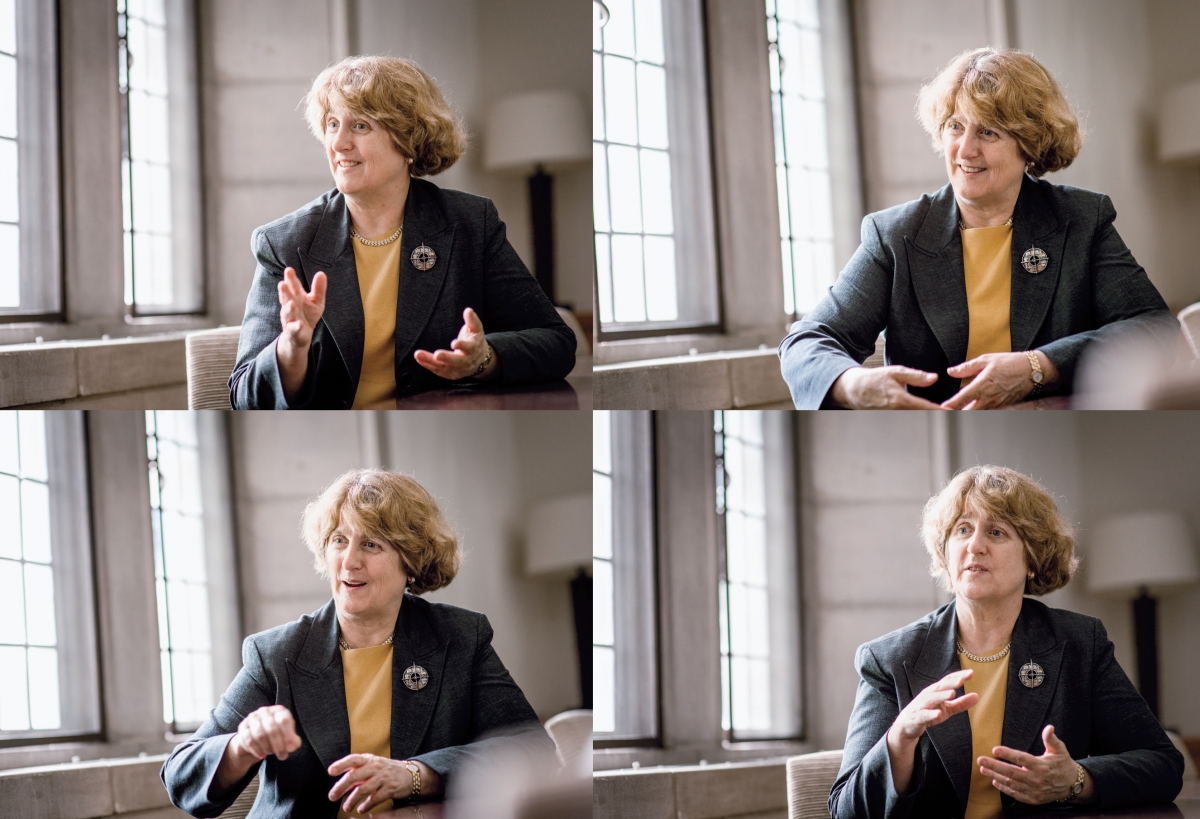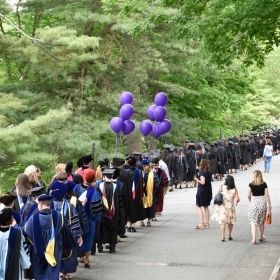Wellesley’s provost and VP for finance and administration talk about the College’s facilities, finances, and academic program
How can Wellesley support the excellence of its programs and faculty, maintain need-blind admissions, and build for the future, all while eliminating an operating deficit and addressing deferred maintenance of buildings?

Andrew Shennan and Piper Orton sit in the expansive Provost’s Office on the third floor of Green Hall, talking about the College’s present—its academic program and faculty, its physical infrastructure, its finances—and its future. The discussion bounces back and forth between them with an ease that makes clear just how many hours they have spent together in meetings, debating subjects like this.
Every generation of College leaders has its own challenges to solve, and these two—Shennan, who is provost and dean of the College, and Orton, who is vice president for finance and administration, and treasurer—have been deeply involved in the issues that are occupying today’s Senior Leadership team. The College is in a position of tremendous strength, but at the same time has many buildings that require significant attention, renovation needs that were assessed under President Kim Bottomly. The job of the current Senior Leadership, led by President Paula Johnson, has been to figure out how to support the excellence of Wellesley’s programs and faculty, maintain need-blind admissions, and build for the future, all while eliminating an operating deficit and addressing deferred maintenance of buildings.
The steps they have taken are resulting this year in budget reallocations, curricular changes, and a voluntary retirement program for faculty and staff. Both Shennan and Orton say they feel tremendous optimism about the College’s future and the opportunities reorganizing is affording. Have a listen to their discussion with Alice Hummer, the editor of Wellesley magazine.
Wellesley magazine: Would you give us an overall sense of the College’s financial health?
Piper Orton: The College remains an incredibly strong institution in so many of the very, very important measures. We’ve had two years of 17 percent increases in applications. In terms of the strength of the student body, the strength of our faculty and staff, and the strength of our endowment and resources—we are fortunate. On the balance-sheet side, we’re very strong and compare very favorably to our peers on those measures. Where we have work to do is that we need to be balancing our investments in our program with our investments in the buildings and infrastructure that support programs and people. That’s where we’ve fallen a bit short historically, and we’re on this pathway to move to a place where we’re balancing those investments consistently over time.
Andrew Shennan: Great institutions are always aspirational institutions. We are filled with people in every constituency—alumnae, faculty, students, staff—who have ideas for how we can more fully fulfill our mission and be an institution that advances women in the world, and educates our students in ever more effective and transformative ways. To my mind, there’s always that pressure from ourselves, from our community, to enhance what we do and extend what we do, and that always means that we will be continually figuring out how many of those aspirations we can achieve at any one time.
If the aspiration weren’t there, we would be in much worse shape. Even though, for sure, from the financial point of view or the resource point of view, there are challenges that go along with being an aspirational institution, I wouldn’t have it any other way.
In recent memos to the campus community about current budget rebalancing at Wellesley, you’ve talked about putting Wellesley on “a multiyear pathway to a sustainable budget model.” What do you mean by a sustainable budget?
Orton: It means that we are not running a deficit every year, which we did for eight of the last 10 years. When we are running a deficit every year, we’re basically continually eating into the operating reserves of the College. There’s no organization that I know of, nonprofit or otherwise, that can run year after year at a deficit. We need to get to a place where we are able to support our everyday programmatic expenses and our facilities-related expenses, as well as address the deferred maintenance in the buildings.

‘A tenure-track line is a commitment potentially for 40 years. You can’t just put all your eggs in one basket. You have to be able to balance tradition and renewal—change, innovation, with the traditional strengths of the curriculum.’
—Andrew Shennan
Shennan: We also want to ensure that the purchasing power of the endowment doesn’t decline, so we’re not borrowing from the resources that will be necessary for future generations.
What steps has the College taken toward a sustainable budget?
Shennan: An integral part of the sustainable budget that Piper described is a budget that provides adequately for the maintenance and renewal of our campus. The first steps that were taken in that direction were to acknowledge and assess the extent of the backlog of maintenance in the buildings. That really began in earnest in 2010. And then coming out of that realization of the backlog, we had to devise a sensible and affordable plan for addressing it. That plan was developed over a number of years. Eventually it was called Wellesley 2025 and then Campus Renewal. With limited resources, what would be the best way for us to address the deficits in our buildings while being attentive to the programmatic needs? And that’s where the priority attached to the Science Center project and to the residence halls came from. So I would see that as being a first step.
From the beginning, it was recognized that that work would require us to shift our operating budget every year and put more of the operating budget into the renewal and maintenance of the buildings. The effort of shifting the budgetary priorities began four or five years ago. We made progress in that direction, but we were not making as swift progress as we wanted to, and so some of the decisions that have been made since President Paula Johnson and Piper Orton came to the College have really closed that gap between where we were and where we need to be, though maybe not completely.
In a budget like ours, most of the money is spent on personnel, on salaries. And so really, that process of rebalancing the budget required us to look at the size of, for example, the academic program, and to move toward a program that is more in line with what it was a decade or two ago and more in line with peer institutions. That has been achieved primarily through the Voluntary Retirement Program (VRP).
Before we get into the VRP, would you speak about the overall state of the College’s facilities?
Shennan: The money that was being spent at the College in the decades leading up to 2010, when we adopted this new focus on the backlog of campus renewal, that money was being well spent to strengthen the College. It’s not that poor decisions were made. It’s that priorities were established that really did a lot to enable the College to be in the strong position that Piper described at the outset. Our firm and unwavering commitment to need-blind admission over many years—that’s the foundation on which we can build the admission strength now. We are one of the very few schools that hasn’t wavered or gone back and forth on that issue. There’s a cost associated with that, which the College was willing to bear.
It’s not the case that no attention was being paid to the buildings. Lots of attention was being paid to the buildings. I think it’s probably just the case that with a campus that has a lot of older buildings, at a certain point, the piecemeal renovation isn’t adequate to the renewal for the long term. The residence halls in the Hazard Quad were built more than 100 years ago, and with buildings of that age, at some point the basics—the roofs and the walls and the windows and the lintels and, you know, everything—require really major investment. The Science Center is closing in on 50 years old. And for a facility like that, a highly technical facility, there comes a time when it needs that major infusion.
So I don’t think it’s that the previous decisions were wrong. I think they positioned the College in a situation of great strength. But the responsibility of any leadership team or any president or board is to look at where the College is right now and ask, What are the responsible steps for the College to take right now? Those responsible in 2010 were clearly recognizing that a lot of our buildings needed significant attention, and that that work should be one of the things that we organized ourselves around.
Why can’t you fund campus renewal with philanthropy? Or even take funds out of the endowment?
Shennan: The extent of the challenge, of the work that we needed to do, was far greater than we could hope to achieve through philanthropy alone. Also, it’s hard to ask people to contribute resources for something that is maintaining buildings—not adding new buildings—but maintaining buildings that we’ve had for a long time, which in a certain sense really are the College’s responsibilities to keep up. So that’s where I see the decision as the right one, that we have a responsibility to use the operating budget to address these issues, and to right-size some of the other parts of our budget in order to make that possible.

‘I’m very optimistic, because there’s such universal agreement and commitment and belief in the mission of the organization. People may disagree about the pathways that we take collectively to get there, but there’s not disagreement about the importance of the work.’
—Piper Orton
Orton: I agree with everything that Andy said—that we can’t raise enough, or raise enough quickly, to address the kinds of needs that we’re talking about. The beauty of a 100-year roof is you’ve got it for 100 years, but the downside of a 100-year roof is you don’t really see the end coming. And the patches only last so long. That’s where we are: Patching and repairing only takes you so far, and then you need to do the entirety of it.
It’s figuring out how to have the resources to do that across a campus with so many old buildings. It all comes due at about the same time. I think the other aspect is that one problem leads to another, just as it does in your home. So the leaking roof leads to water damage on the ceiling, and then you need to replace that as well.
To the question of whether we can take care of deferred maintenance by just taking large amounts out of the endowment: In terms of our operating budget, we depend heavily on the distribution from the endowment to support all that we’re doing on a year by year basis. For example, when you look at the numbers, an increasing amount of our financial aid needs to be funded through gifts that are not restricted to financial aid. And those percentages are pretty noticeable over time.
So we need all of the distribution on that endowment to support what we’re currently doing. If we take a large amount out of the endowment to invest in the buildings, we do solve one problem more quickly, but we create another problem, which is a gap in the operating budget. We then need to figure out how we fill that gap.
Tell us about the Voluntary Retirement Program. How did it originate? Who was eligible for the program, and how successful was it?
Shennan: The impetus for the Voluntary Retirement Program came from the president and Senior Leadership, but it reflected the prior work of the Budget Advisory Committee [the BAC, a faculty committee currently chaired by Casey Rothschild, Hess Associate Professor of Economics]. The idea of rebalancing the budget didn’t originate in the BAC, but I think the work that the BAC has done since 2016—in identifying steps that the College could take to have a budget that would allow us to invest more in the buildings—was very important.
Orton: The BAC identified three areas that they felt the College needed to focus on.
The first was revenue. Our comprehensive fee had fallen below the comprehensive fee of peer schools. This was disadvantaging us in terms of our overall budget with very little gain. Because of our commitment to need-blind admission and fully funding need, if we increased our comprehensive fee, we would always increase our aid to make up that gap. We could catch up and still maintain our commitment to accessibility, inclusiveness, and diversity. The other piece of the revenue was to think about other activities consistent with our mission that might generate additional revenue.
The second area was the size of the academic program—to adjust it to be more in line with peer institutions, which would mean a reduction in the size of the faculty by roughly 30.
The third area that they identified was to look at nonacademic, administrative functions to ensure that we were being as cost-effective as possible.
The VRP came out of these recommendations. Faculty and administrative staff 60 years of age or older with at least 10 years of service at the College were eligible. It was very successful and very well received by faculty and staff—56 percent of eligible staff and 31 percent of eligible faculty accepted the package. We provided lots of resources to people and their families. If they wanted to meet with a financial planner, they could. There were information sessions having to do with retirement, Medicare, Social Security. It was seen as a meaningful option for people who might already have been considering retirement.
There are 30 senior faculty retiring this year, and four next year. How will that affect the curriculum in both the short term and the long term?
Shennan: In the short term, not knowing where the gaps were going to be, we did a little more hiring of visiting lecturers for next year than we have been doing in the past few years. Ultimately, the goal has been, and we’ve stated it this way, to shrink the curriculum to a modest extent. If the overall curriculum shrinks, then that will relieve the pressure on our having to hire new faculty to replace the people who’ve accepted the VRP.
We think the right way to do this is not just to cut out curriculum wherever the people who happen to take the VRP were teaching. That wouldn’t be a responsible way of dealing with it. What we’re doing right now actually is identify the departments or programs that have been significantly affected by the choices that faculty made to retire. We need those departments to be at the standard of excellence that they’ve been in the past, and so I think that we will need to direct tenure track lines toward those departments.
And then in the longer term, over the next several years, I think we’ll gradually, as other people retire, be able to direct resources in new directions. It’s an art, not a science, because think of all the things that you’re balancing. You’re balancing today’s students’ interests, so you’re balancing the huge interest in computer science with the need to maintain disciplines that have been central to a Wellesley liberal arts education for many, many years. Student interests change over time. A tenure-track line is a commitment potentially for 40 years. You can’t just put all your eggs in one basket. You have to be able to balance tradition and renewal—change, innovation, with the traditional strengths of the curriculum. You have to be somewhat attentive to the changing demographics of our students and our faculty. You have to be attentive to the different ways in which faculty are trained in graduate school.
What we can teach is partly shaped by what young scholars are taught in Ph.D. programs, and so we can’t ignore that. So definitely, we’ll be hiring people with specializations that probably 20, 25 years ago, when I came to the College, didn’t exist. So it really is an art, not a science.
Will the VRP open up any opportunities for the curriculum?
Shennan: I think about the academic landscape, using the landscape of the College as a model. If you will, the established departments are the buildings that have claimed the hills. Given the constant expansion and renewal of academic disciplines outside Wellesley—in academia in general—I don’t think that the answer for us can be just to invest in the buildings on the hills. We have to invest in the landscape between them, that connects them. And that’s really how I think about our commitment to interdisciplinarity and interdepartmental programs. We’ve got to facilitate the passage of faculty from one area to another, not in an artificial way, and students also, not in an artificial way.
It really needs to be organic. It needs to grow out of the expertise of the faculty and the interests of students.
I think that we should continue to support, and even develop, the connections between different disciplines. I hope that we will appoint more people into two departments or give more people interdepartmental appointments.
Would you speak to what is happening on the staff side?
Orton: The BAC wanted to see that the administrative functions of the organization that support the academic program are being conducted in the most effective way possible. We have 38 staff who elected the VRP. And so that is also opening up possibilities similar to what Andy talked about on the faculty side. We’re working with managers to really think before we leap. It’s pausing long enough to think about what our priorities are. What are the highest value things that we want to do and focus on? How do we think about deploying the people that we have and the positions that we have? So it may be replacing the position of the person who retired or resigned, but it may be reorganizing and refocusing other work.
Any last thoughts?
Shennan: I think that the College is a stronger place today than it’s certainly ever been in my time here. I think that the academic caliber and the diversity of our student body are extraordinary, and that we continue to have one of the broadest and best academic programs of any liberal arts college in the country.
Orton: And I’m very optimistic, because there’s such universal agreement and commitment and belief in the mission of the organization. People may disagree about the pathways that we take collectively to get there, but there’s not disagreement about the importance of the work. It has felt to me from the beginning that we undertook this work from a position of great strength.

